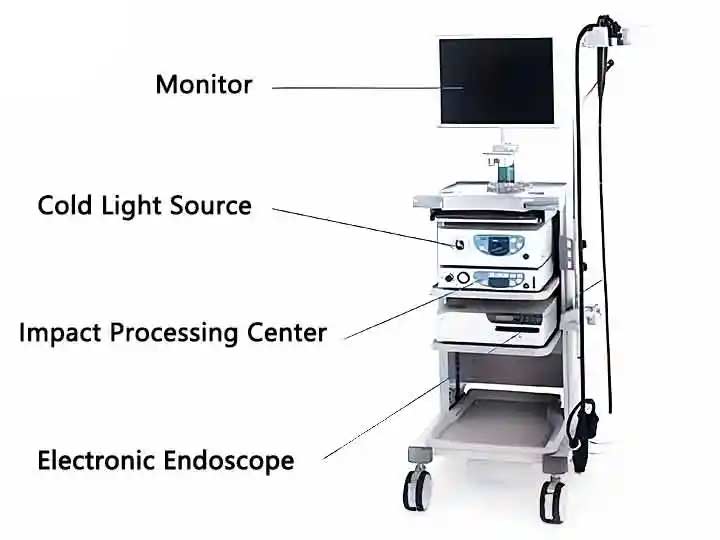Table of Contents
In the fields of modern medicine and industrial testing, endoscopy has become an indispensable tool for examination and diagnosis due to its unique advantages. Endoscope is a complex device that integrates traditional optics, ergonomics, precision machinery, modern electronics, mathematics, and software technology. Endoscope is a detection instrument that integrates traditional optics, ergonomics, precision machinery, modern electronics, mathematics, and software. It has image sensors, optical lenses, light source illumination, mechanical devices, etc. It can enter the stomach through the mouth or enter the body through other natural channels. Endoscopy is very useful for doctors as it allows for the visualization of lesions that cannot be shown by X-rays. For example, with the help of an endoscope, doctors can observe ulcers or tumors in the stomach and develop the best treatment plan based on this.
In terms of application, it can be simply divided into two categories: industrial endoscopes and medical endoscopes.
Regarding the types of industrial endoscopes, they are divided into optical endoscopes, fiber optic endoscopes, electronic endoscopes, CCD video endoscopes, CMOS video endoscopes, and electric 360 ° endoscopes based on their imaging forms. According to the types of endoscope light sources, they are divided into high-frequency fluorescent lamp endoscopes, fiber halogen lamp endoscopes, and LED endoscopes.
From an application perspective, endoscopes can be roughly divided into two categories: industrial and medical. The development history of medical endoscopes is long, and their imaging structures and technologies continue to evolve. Currently, they can be mainly divided into three categories: rigid tube endoscopes, optical fiber (flexible tube) endoscopes, and electronic endoscopes.
Regarding the classification of medical endoscopes, they can be roughly divided into three categories based on their development and imaging structures: rigid tube endoscopes, optical fiber (flexible tube) endoscopes, and electronic endoscopes.
There are many different types of endoscopes used for medical examinations, each with its own classification method. Generally speaking, the following three classification methods are more commonly used. In terms of market sales, the most commonly used categories are hard lenses and flexible lenses based on whether they can change direction in clinical practice.
Hard tube endoscopy is one of the early forms of endoscopes, which is made of metal or hard plastic and equipped with optical components and a light conduction system inside. Due to its simple structure and durability, rigid tube endoscopes still have applications in some specific medical settings. However, due to its lack of flexibility, it may not be ideal for certain complex inspection requirements.
The emergence of optical fiber (flexible tube) endoscopes represents a major advancement in endoscopic technology. It uses optical fibers as the light conducting medium, giving the endoscope better flexibility and a wider viewing angle. Optical fiber endoscopy is not only suitable for surface examination, but also for observing deep tissues, thus it has been widely promoted in clinical applications.
Electronic endoscope is the latest type of endoscope that uses electronic technology for imaging. It is equipped with a miniature camera and image sensor, which can convert observed images into electrical signals and display them through a video processing system. Electronic endoscopes have high image clarity, flexible operation, and can be connected to other medical devices through various interfaces to achieve data transmission and storage. In addition, electronic endoscopes also have a magnifying function, which can provide a more detailed observation of the lesion site.
Industrial endoscopes are mainly used for inspection and maintenance work in various industrial fields. According to different imaging forms, industrial endoscopes can be divided into various types such as optical endoscopes, fiber optic endoscopes, electronic endoscopes, CCD video endoscopes, CMOS video endoscopes, and electric 360 ° endoscopes. These different types of industrial endoscopes have their own characteristics and can meet the detection needs in different situations. Meanwhile, industrial endoscopes can be further subdivided based on the type of light source, such as high-frequency fluorescent lamp endoscopes, fiber halogen lamp endoscopes, and LED endoscopes.

Whether for medical or industrial use, the basic working principle of endoscopes is based on optical imaging principles. Taking medical endoscopes as an example, the light emitted by the light source is transmitted through a light beam (fiber optic) to the internal tissues of the human body. The part to be examined is imaged by the objective lens on a surface array CCD, and then the CCD driving circuit controls the CCD to collect images and output standard video signals for doctors to observe and analyze. This non-invasive examination method greatly reduces the patient's pain, while also improving the accuracy and efficiency of diagnosis.
Endoscope, as an advanced detection tool, plays an important role in both medical and health fields as well as industrial production. With the advancement of technology, the technology of endoscopes is constantly innovating and improving. In the future, more innovative endoscopic products will emerge, providing stronger guarantees for human health and production safety.
Copyright © 2025.Geekvalue All rights reserved.Technical Support:TiaoQingCMS